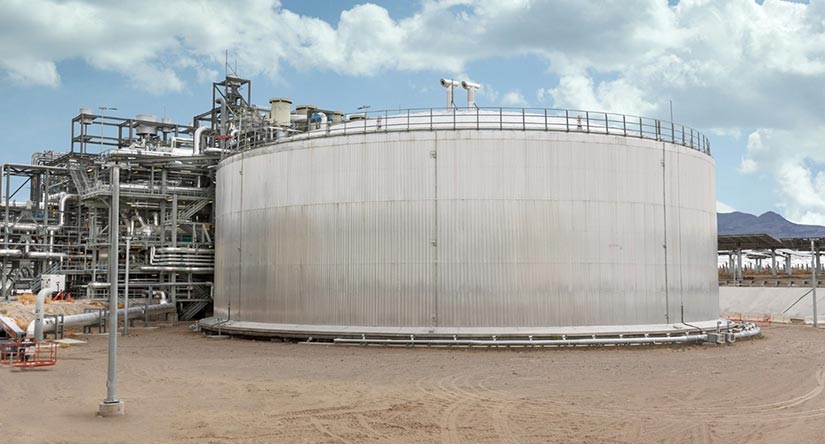
High-efficiency options for storing renewable energy include thermochemical energy storage
Energy storage technology is now one of the most important tools for advancing the energy transition due to the rising demand for renewable energy sources worldwide. The benefits of high density, high efficiency, and long-term storage have made thermochemical energy storage a novel energy storage technique that has steadily gained popularity. Thermochemical energy storage stores heat energy in chemicals through chemical processes and releases it when needed, in contrast to conventional physical energy storage techniques. In addition to successfully resolving the conflict between energy supply and demand, this technology offers a fresh approach to enhancing the dependability of renewable energy sources. This essay will examine the fundamental ideas, benefits, primary components, and prospective uses of thermochemical energy storage in the future.Regarding energy storage technology, you can also look into lithium-ion battery energy storage, modular energy storage, and battery energy storage system design.
What is energy storage using thermochemistry?
Using chemical processes to transform heat or other energy into chemical energy storage and then reacting in reverse to release energy when needed, thermochemical energy storage is a cutting-edge energy storage technique. With the benefits of minimal heat loss and high energy storage density, technology can store enormous amounts of heat over extended periods of time. Thermochemical energy storage is considered a hot technology for energy storage in the future since it plays a significant part in the energy transformation process and has a higher energy density and longer storage period than conventional energy storage techniques.
Thermochemical energy storage principles
Latent heat storage and traditional sensible heat storage are not the same as thermochemical energy storage. Substances are changed in the thermochemical energy storage process. The idea is to store and release heat energy by utilizing the endothermic and exothermic characteristics of chemical reactions. For energy storage, the particular process is an endothermic reaction in which the reactants break down into multiple products, which are then stored independently. When the need for energy release arises, the products come into contact with one another through an exothermic reaction, which releases heat energy.
Thermochemical energy storage properties
Conditions for energy storage are loosened.
As long as the endothermic reaction's products are kept apart, heat energy can be transformed into chemical energy for storage.Long-term and long-distance energy storage can be accomplished without expanding insulating infrastructure.
high density of energy storage
Compared to sensible heat and latent heat energy storage, the energy storage density is 8–10 times that of sensible heat materials and more than twice that of latent heat materials due to the breaking and rearranging of chemical bonds during the chemical reaction process.
Minimal heat loss
Chemical reaction products are comparatively stable during storage, which can lower energy loss through heat and increase the effectiveness of energy storage.
Broad range of temperatures
Numerous temperature applications exist for thermochemical energy storage materials, particularly in the area of high temperature energy storage.
Typical thermochemical energy storage materials
Metal hydroxide systems, metal oxide systems, hydrated salt systems, carbonate systems, ammonia decomposition systems, and so forth are examples of commonly used thermochemical energy storage materials. Different materials have varying temperatures and can be chosen based on the temperature required for energy storage.
system of hydrated salts
Crystalline water is eliminated, hydrate is thermally broken down, and heat energy is transformed into chemical energy for storage in the hydrated salt energy storage process. The properties of hydrated salt include low corrosion and non-toxicity. The hydrated salt system is mostly utilized for thermochemical energy storage at low temperatures, with representative thermochemical materials operating in the 50°C to 150°C temperature range. NaS2•5H2O, MgSO4•7H2O, SrBr•6H2O, and MgCl26H2O.
System of metal hydroxide
The primary application of the metal hydroxide system is in medium temperature thermochemistry.CaO/Ca(OH)2 and MgO/Mg(OH)2 are two thermochemical materials that are frequently used for energy storage. They have the benefits of being non-toxic, inexpensive, and having high cycle performance. Typically, the temperature range that applies is 100°C to 550°C.
Oxide of metal
High-temperature thermochemical energy storage frequently uses metal oxides. BaO2/BaO and Co3O4/CoO are two popular thermochemical materials that offer the benefits of good cycle stability, no byproducts, and no side reactions. Typically, the temperature range that applies is 400°C to 1026°C.
Examples of thermochemical energy storage applications
Applications for medium and low temperature thermochemical energy storage include industrial waste heat usage under appropriate temperature circumstances and central heating for office, commercial, medical, and residential buildings. Numerous studies on building heating have been conducted in nations including Canada, Germany, and Austria. The solar collector is integrated with the thermochemical reactor. Additionally, the endothermic thermochemical reaction is powered by the heat of the sun during the day, and the solar energy is transformed into chemical energy storage. At night, the reverse exothermic reaction can heat the water and air in the house. Cross-season energy storage heating for buildings is possible due to thermochemical energy storage's superior long-term energy storage benefits.
High temperature thermochemical energy storage is mostly utilized because its operational temperature range is compatible with that of tower solar power generating.By adding thermochemical energy storage devices, the issue of fluctuating solar radiation can be resolved, and power generation time, capacity factor, and cost can all be increased. China, Germany, Australia, and other nations are carrying out significant research in this area.
In conclusion
With its high energy density, extended storage period, minimal heat loss, and broad temperature range, thermochemical energy storage technology exhibits enormous promise for use in future energy systems. As technology develops and the industry continues to mature, thermochemical energy storage will play a significant role in advancing energy transformation and the growth of renewable energy sources. In the energy landscape of the future, it will be crucial in offering robust backing for the global development of sustainable energy.

Comments 0